•
Renovation of the Historic Isaac H. Lionberger House
A partnership consisting of the
principals of Rodemyer-Christel purchased the Historic Lionberger House in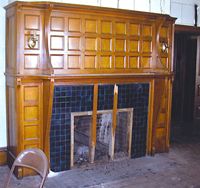 November, 2003. The building was boarded up and had been vacant for more than five years. All
electric, plumbing, and heating and cooling systems had been removed. Many
November, 2003. The building was boarded up and had been vacant for more than five years. All
electric, plumbing, and heating and cooling systems had been removed. Many
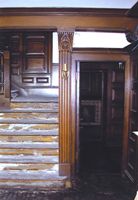 interior architectural details had been covered up over the years or were
partially damaged and/or missing. Fireplaces and beautiful original woodwork
had been covered over with painted plywood. Plaster walls and ceilings had
collapsed. Stone retaining walls around the building had been reduced to rubble
and trees and weeds had overtaken the lot. One of the previous owners had
changed the original entranceway of the building, covering up brick arches and
marble stairs. The majority of the windows had been removed and the openings
were boarded up. Broken and missing windows freely allowed pigeons to roost in
the third floor of the home.
interior architectural details had been covered up over the years or were
partially damaged and/or missing. Fireplaces and beautiful original woodwork
had been covered over with painted plywood. Plaster walls and ceilings had
collapsed. Stone retaining walls around the building had been reduced to rubble
and trees and weeds had overtaken the lot. One of the previous owners had
changed the original entranceway of the building, covering up brick arches and
marble stairs. The majority of the windows had been removed and the openings
were boarded up. Broken and missing windows freely allowed pigeons to roost in
the third floor of the home.
Our renovation plans included preserving as much historical detail as possible. Our plans were to move the corporate offices of Rodemyer-Christel, Inc. to the property to occupy the lower level, first and second floors. The third floor would be converted into a large residential loft apartment.
Background of this Historic St. Louis Landmark
The
Isaac H. Lionberger House was designated a City of St. Louis Landmark in April,
1975. The house consists of three floors plus a lower level, and contains
approximately 8600 square feet. This historic house is the only surviving
one of three St. Louis works designed by one of America's most important
architects, Henry Hobson Richardson. 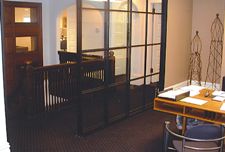 Literature suggests that this
property is the only remaining H. H. Richardson designed building west of the
Mississippi. Trinity Church in Boston, the Marshall Field Wholesale Store
in Chicago, the Allegheny County Courthouse, academic buildings at Harvard, and
many elegant private residences for America's elite, such as the family of Henry
Adam's, and John Hay's, marked some H. H. Richardson's architectural
accomplishments.
Literature suggests that this
property is the only remaining H. H. Richardson designed building west of the
Mississippi. Trinity Church in Boston, the Marshall Field Wholesale Store
in Chicago, the Allegheny County Courthouse, academic buildings at Harvard, and
many elegant private residences for America's elite, such as the family of Henry
Adam's, and John Hay's, marked some H. H. Richardson's architectural
accomplishments.
St. Louisan, George Shepley joined the office of H. H. Richardson in 1882. Shepley would later marry Richardson's daughter, Julia. Isaac Lionberger married George Shepley's sister, Louise Shepley. It was therefore very logical that when Isaac Lionberger's wealthy father was going to have a home constructed as a wedding gift for Isaac and his new bride, that he would have commissioned H. H. Richardson (whose chief assistant, George Shepley, was Isaac's brother-in-law). The commission to design the home occurred in 1886.
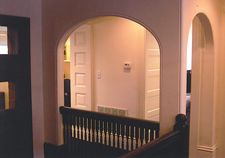 H. H. Richardson died in April, 1886 before the final drawings for the home were
completed, however there is much evidence that the schematic drawings were
completed and approved by Richardson (his comments appear on several drawings),
so the house can justifiably be included among the great architect's projects.
Additional evidence is found in a letter to George Shepley, dated March 6, 1886,
from H. H. Richardson that noted that the plans were completed and been sent to
St. Louis. The original plans for the home are currently held in the
Harvard School of Architecture.
H. H. Richardson died in April, 1886 before the final drawings for the home were
completed, however there is much evidence that the schematic drawings were
completed and approved by Richardson (his comments appear on several drawings),
so the house can justifiably be included among the great architect's projects.
Additional evidence is found in a letter to George Shepley, dated March 6, 1886,
from H. H. Richardson that noted that the plans were completed and been sent to
St. Louis. The original plans for the home are currently held in the
Harvard School of Architecture.
In 1886, Isaac Lionberger was a member of the prominent St. Louis Law firm, Lionberger & Shepley. He remained at that firm until 1896, when he became the Assistant Attorney General of the United States.
Renovation Details
We worked closely with our architects and
contractors to design the mechanical systems so they would be minimally
intrusive on the architectural elements of the building. The City of St. Louis
Fire Codes required significant
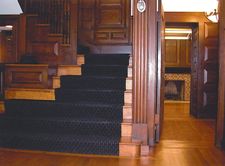 expenditures
to sprinkler the building and add components to meet current day life safety
standards for commercial and residential mixed use property. All
modifications required by the Fire Codes were incorporated into the structure in
such a way as not to damage or detract from the
original floor plan and architectural details. Six fireplaces were
uncovered and missing elements were handcrafted to match the existing details.
The original facade of the building was completely tuck pointed, cleaned, and
the original entranceway was restored. All windows were replaced. The brick
details and window pattern that existed prior to the addition in 1894 were
exposed and restored. Hardwood floors were cleaned of all old mastic and vinyl,
repaired and restored. Skylights and decorative glass insets were restored and
rehung. All existing original wall sconces were restored and rehung. Exterior
granite caps on the retaining walls were cleaned and reset in place on top of
new retaining walls. Exterior site improvements and landscaping finished off
the elegant restoration of this St. Louis Landmark.
expenditures
to sprinkler the building and add components to meet current day life safety
standards for commercial and residential mixed use property. All
modifications required by the Fire Codes were incorporated into the structure in
such a way as not to damage or detract from the
original floor plan and architectural details. Six fireplaces were
uncovered and missing elements were handcrafted to match the existing details.
The original facade of the building was completely tuck pointed, cleaned, and
the original entranceway was restored. All windows were replaced. The brick
details and window pattern that existed prior to the addition in 1894 were
exposed and restored. Hardwood floors were cleaned of all old mastic and vinyl,
repaired and restored. Skylights and decorative glass insets were restored and
rehung. All existing original wall sconces were restored and rehung. Exterior
granite caps on the retaining walls were cleaned and reset in place on top of
new retaining walls. Exterior site improvements and landscaping finished off
the elegant restoration of this St. Louis Landmark.
In 2006, David and Jill Belsky were presented with an award for their work in renovating this historic structure. The Landmark Association of St. Louis presented the "Most Enhanced Property" award to the Belsky's at a ceremony held during Historic Preservation week.
The complete rehab of the structure took approximately 10 months. The project was privately financed and received State and Federal Historical tax Credits. The Historic Isaac H. Lionberger House is now once again an integral part of the Grand Center Neighborhood in St. Louis, and can once again radiate the charm, grace, and sophistication designed into the property by the late H. H. Richardson.
•